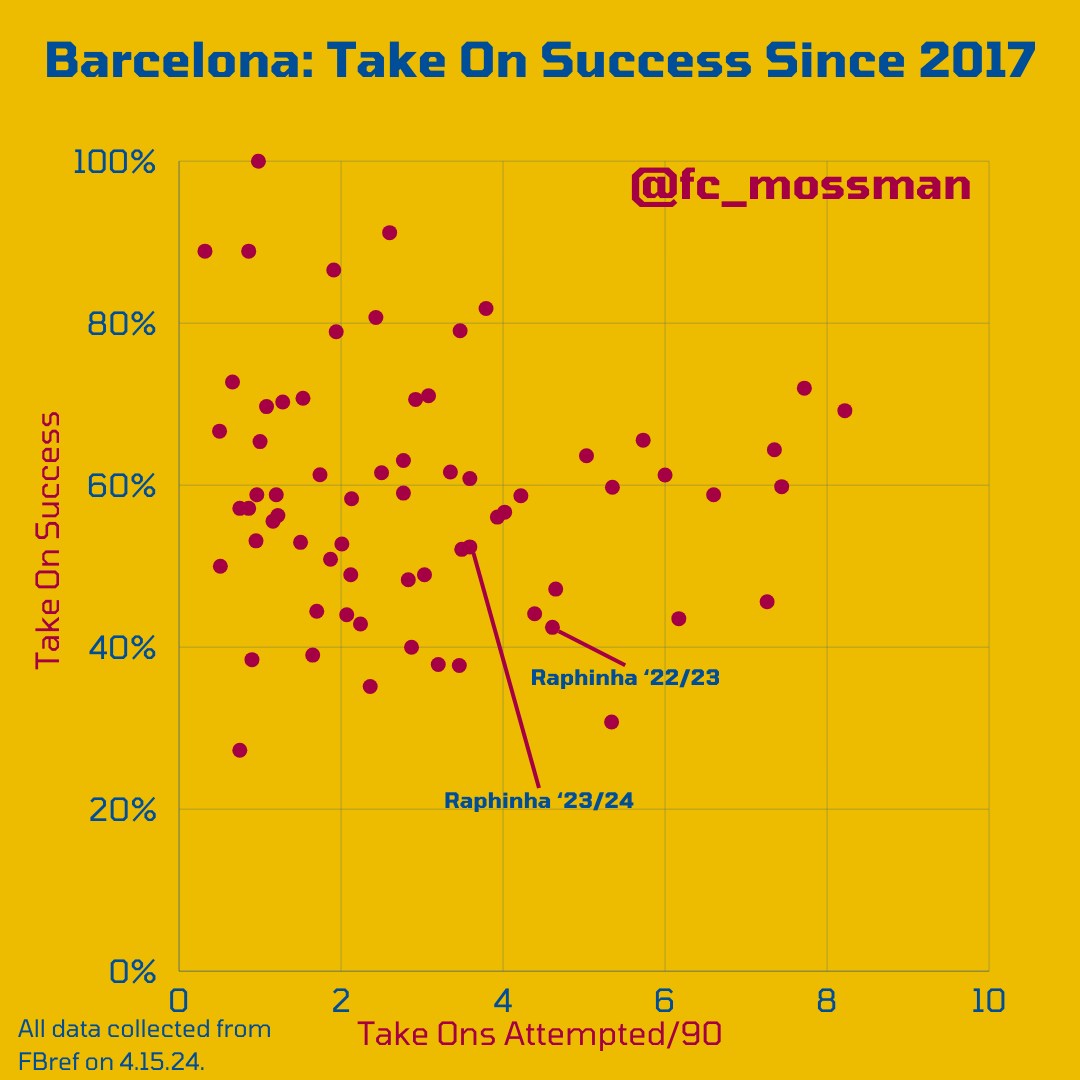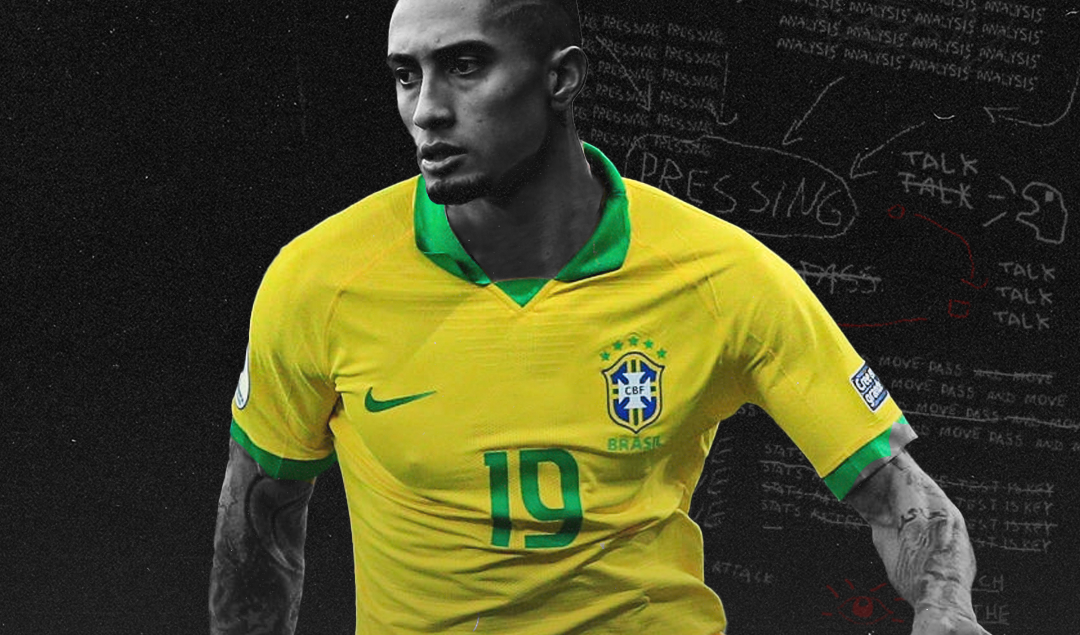Raphinha: Challenging the Stereotypes of Brazilian Wingers at Barcelona
Since 2017, two La Liga players have managed at least 0.40 non-penalty expected goals and 0.40 expected assisted goals per 90 minutes in the same season. Lionel Messi has done it three times (‘17/18, ‘18/19, ‘19/20), and Raphinha has done it twice (‘22/23, ‘23/24) since swapping Leeds for Barcelona in the summer of 2022.

Take a moment to process that. Think about all of the attacking talent to grace La Liga in the past eight years… players like Cristiano Ronaldo, Luis Suarez, Karim Benzema, Antoine Griezmann, Ousmane Dembélé, and Vinicius Jr. It is a long list of stars who have plied their trade during that time, but only two have been able to hit a premier threshold in both expected goal scoring and expected chance creation. Even Messi failed to hit that threshold in the ‘20/21 campaign, but Raphinha has done it in both his seasons for Barcelona.
Bearing in mind he finds himself in the statistical company of world-class attackers like Antoine Griezmann and Messi, you would think that Raphinha would be lauded as next in the long line of Brazilian wingers to captivate and dominate at the Camp Nou. The fact of the matter is, however, that Barcelona supporters (at least the ones with opinions they are willing to voice online) have, at best, a love-hate relationship with Raphinha.
Pau Cubarsí vs. Atlético Madrid:
-6 clearances
-2 blocked shots
-1 interception
-1 tackle
-73/77 passes completed
-1 key pass
-1 big chance created
-2/2 aerial duels won
-7/10 ground duels won@JJMont3ro on Barcelona’s teenage prodigy in central defense: https://t.co/ZsIrYdMt3t pic.twitter.com/l1Frhcmdvo— Breaking The Lines (@BTLvid) March 18, 2024
He receives plaudits after stellar performances, like the one in the first leg of the UCL quarterfinal tie against PSG, but in general, he receives far more criticism than most of their regular first team players. I have grappled with the chasm between my observations of Raphinha as a player and Barcelona supporters’ perception, and I believe I have found the answer.
To deconstruct the gap between Raphinha’s reputation with the Barcelona fan base, and what my eyes and the analytics tell me, let’s first get an objective understanding of the type of player he is.

To do so, I have built his positioning and progression in possession profile, comparing him to a sample group of 278 La Liga attacking midfielders and wingers with at least 900 league minutes over the past three league seasons. A couple of observations to help the radar chart make more sense:
- He rates in the 82nd percentile in “vertical positioning”, a metric I created to judge how far up the pitch a player typically sees the ball in possession. A high number does not represent a good or bad attribute, it simply means that he plays further up the pitch than 82% of La Liga attacking midfielders and wingers.
- The right side of the graph compares his abilities in progressive passing and carrying, as well as receiving the ball deep. It adjusts for team environment, giving a boost to players that perform well in each statistical grouping despite playing in a team that might not be conducive to high marks in that particular stat. He rates in the 81st percentile for both adjusted progressive receptions and passing, while “only” in the 58th percentile for progressive carrying.
- The left side shows the player’s reliance on each of the progressive actions. Raphinha is pretty balanced.
One observation that immediately stands out to me is that ball carrying is his least productive, and least relied upon method of progression. He does not strike me as an exceptionally gifted dribbler, but it is not necessarily a weakness either. I believe herein lies much of the Barcelona supporters’ anguish with Raphinha.
After playing a pivotal role in Manchester City’s treble, İlkay Gündoğan has flourished since making the move to Barcelona on a free transfer, and at 33, he continues to demonstrate why he is one of the finest midfielders in world football.@fc_mossman: https://t.co/zzW4SkI5Mp pic.twitter.com/wyyEKaaC2C
— Breaking The Lines (@BTLvid) April 4, 2024
The fan base has been spoiled by arguably the two flashiest and most technically-gifted dribblers to ever touch a football in Neymar and Ronaldinho. And I do not mean spoiled with a negative connotation – any group of supporters would hold their players to lofty, almost-unattainable standards if these two were the benchmark.
To be a revered Brazilian winger for the Blaugrana, you need to be more than productive; dazzling while you do it is a prerequisite. And while it is not as if Raphinha plays without class, it is just that he does not have that Jogo Bonito it-factor. Take, for example, Barcelona’s take-on statistics for full backs, midfielders, and attackers since 2017.

Raphinha ranks towards the bottom of the group in both volume of dribbler take ons and success rate. Unfortunately, Neymar left Barcelona the year before Opta started tracking take ons as a statistic, so he is not in the sample group. But, even a player like Philippe Coutinho, who did not come close to living up to expectations, bested both Raphinha’s seasons in both volume and success rate.
Not only that, but non-Brazilian wingers like Ousmane Dembélé and Lamine Yamal have carried the metaphorical torch with their exceptional dribbling abilities. Pair the nostalgia of players like Ronaldinho and Neymar with the reality that even underperforming wingers still had excellent take on marks, and it starts to make sense why Raphinha is yet to earn the love and adoration of the Barça faithful.
So, if not a wizard in tight areas, what are the biggest highlights of Raphinha’s game? While he doesn’t dribble like certain legendary figures, he does a couple of things exceptionally well. The first: he’s the best chance creator in La Liga, and possibly the entire world.

Comparing his chances created and xAG per 90 league minutes this season to all outfield La Liga players with at least 900 minutes, it is genuinely astounding how much better Raphinha is than everybody else. He ranks as the third best in chances created and runaway first in expected assisted goals.
To put the astronomical xAG figure into perspective: the difference between the Raphinha’s 0.41 xAG/90 and the second highest number (Largie Ramazani with 0.34), is the same as the difference between second and eleventh (Lamine Yamal with 0.27).
Not only is he a world-class chance creator, but offers defensive effort not typically seen by wide area attackers of his class.

Comparing him to all La Liga attacking midfielders, wingers, and forwards with at least 900 league minutes this season, Raphinha is above the median in tackles, interceptions, blocks, clearances, and recoveries per 90 minutes. He is one of only nine players to meet this criteria.
He also has the highest vertical positioning score of any of the nine players that rank above the median in all five categories. Remember that his vertical positioning score is in the 82nd percentile for this sample group? The average vertical positioning percentile score of the eight other players is the 26th percentile. In other words, despite Raphinha’s positioning high up the pitch, his defensive counting stats reflect a player that takes up wingback-like positions.
Lamine Yamal doesn’t turn 17 until July, but he’s already emerged as a key figure in attack under Xavi and become the youngest player in La Liga history to register 10+ goal contributions in a season.@free__flowing analyzes Barcelona’s teenage phenom:https://t.co/R2XrGD1pt4 pic.twitter.com/w1923KRd44
— Breaking The Lines (@BTLvid) February 15, 2024
Will Barça supporters ever be able to separate the reality of Raphinha’s gifts from their preconceived biases towards flashy dribblers? I would be surprised if the answer is yes. My request to Barcelona fans across the world: do not let your club’s history of Jogo Bonito Brazilian wingers cloud your judgment on the quality of player you have with Raphinha.
He is one of the best facilitators in world football, offers an exceptional defensive work rate compared to his positional peers, and he gives his all for the club every time he steps on the pitch. If you understand who Raphinha is as a player and accept that he’s not Ronaldinho or Neymar, who knows… you might find yourself wistfully lamenting that the next Brazilian winger to don the blue and garnet does not live up to the standard he has set. Nostalgia can be a peculiar sentiment!
By: Spencer Mossman / @fc_mossman
Featured Image: @GabFoligno / James Williamson – AMA / Getty Images Sport
